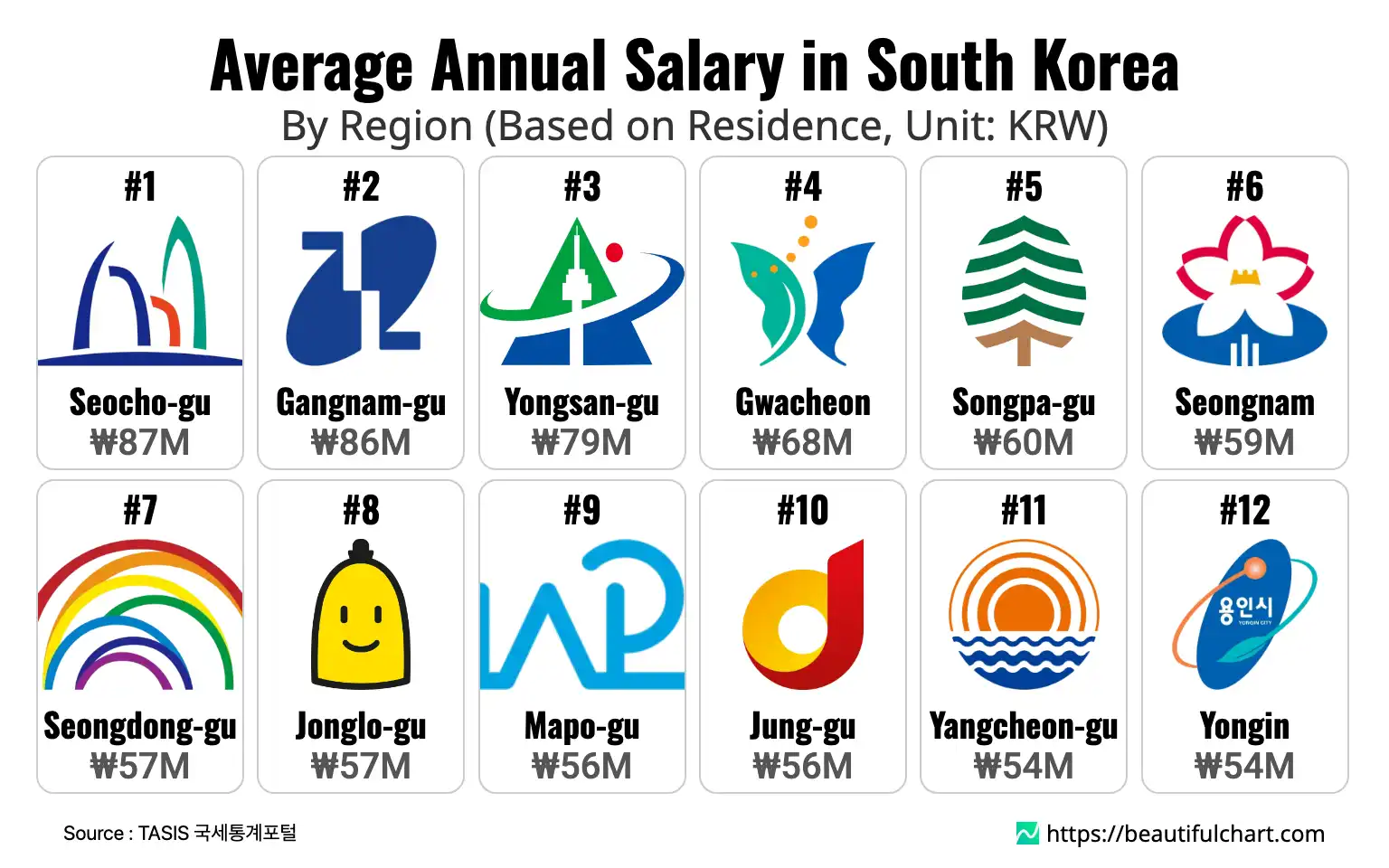This chart provides a detailed ranking of average annual salaries across various regions in South Korea. The data reveals a significant income disparity, with metropolitan districts, particularly in Seoul, occupying the top positions. Seocho-gu and Gangnam-gu lead the nation in average earnings, highlighting a strong concentration of wealth in the capital's core areas. In contrast, other regions show considerably lower average incomes, illustrating the economic landscape across the country.

Regional Income Disparity refers to the unequal distribution of income across different geographical areas within a country. This economic indicator often highlights the concentration of wealth and economic opportunities in specific urban or industrial centers while other regions may lag. Analyzing this disparity is crucial for understanding a nation's overall economic health and for developing policies aimed at balanced regional development.
An examination of regional income levels in South Korea reveals a landscape marked by profound economic centralization. The concentration of high-paying jobs, corporate headquarters, and wealth within the Seoul Metropolitan Area, particularly in a few core districts, is a defining characteristic of the nation's economy. This phenomenon is not merely a statistical curiosity; it reflects deep-seated structural patterns that influence everything from real estate prices to individual career trajectories and balanced national development.
The Unwavering Dominance of the Seoul Capital Area
The findings underscore the economic supremacy of Seoul. Districts such as Seocho-gu, Gangnam-gu, and Yongsan-gu consistently appear at the apex of income rankings. This is attributable to the dense clustering of headquarters for major conglomerates (chaebols), leading financial institutions, top-tier law firms, and a burgeoning tech industry. These sectors offer the most lucrative salaries in the country, creating a powerful magnetic pull for top talent from across the nation and abroad. The high property values in these areas also correlate with higher resident incomes, creating a self-reinforcing cycle of wealth. This level of centralization is more pronounced than in many other developed economies, such as the United States, where multiple distinct economic hubs like New York, Silicon Valley, Los Angeles, and Chicago exist. In South Korea, Seoul functions as the undisputed singular hub for nearly all high-value industries.
Economic Centralization and its Broader Consequences
This intense concentration of economic power in Seoul has far-reaching consequences. It fuels a continuous 'brain drain' from provincial regions, as ambitious and highly-skilled workers migrate to the capital in search of better opportunities. This exodus can stymie local economies, leading to population decline and a diminished tax base in areas outside the capital region. The result is a widening development gap between Seoul and the rest of the country. Furthermore, the hyper-concentration drives up the cost of living, especially housing, in the capital to astronomical levels, placing immense financial pressure on its residents. This creates a stark contrast with lower-income regions, which often grapple with economic stagnation, an aging population, and a lack of dynamic job creation.
Understanding the Economic Landscape of Other Regions
Regions at the lower end of the income spectrum are often characterized by economies reliant on traditional manufacturing, agriculture, or services catering to a local, and sometimes declining, population. Many of these areas are former industrial powerhouses that have struggled to adapt to a post-industrial, knowledge-based economy. The decline of industries like textiles in Daegu or heavy manufacturing in parts of Busan has left an economic vacuum that has not been filled by new growth engines. These regions often lack the infrastructure, investment, and human capital necessary to attract the high-tech and financial service companies that propel the economies of top-tier districts. Consequently, they offer fewer high-wage employment opportunities, contributing to the significant income disparity seen across the country.
Key Takeaways
Overwhelming Economic Concentration in Seoul
- The highest average annual salaries are overwhelmingly concentrated in specific districts of Seoul.
- Seocho-gu, Gangnam-gu, and Yongsan-gu occupy the top ranks, reflecting their status as centers of business, finance, and high-value professions.
- This intense concentration of wealth in the capital highlights a significant economic imbalance within the nation.
- The income levels in these top districts are substantially higher than in any other region in the country.
Significant Regional Income Disparity
- A vast gap exists between the average incomes of the highest and lowest-earning regions.
- The salary in top-ranking Seoul districts is more than double, and in some cases nearly triple, that of the lowest-ranking areas.
- Many regions outside the Seoul Metropolitan Area, particularly rural and smaller cities, are positioned at the lower end of the income scale.
- This disparity points to unequal economic opportunities and development across South Korea.
Top Ranking
Rank 227: Jung-gu (Busan) ₩28,889,000
As the lowest-ranking region, Jung-gu in Busan faces significant economic challenges. Historically the city's central district, it has experienced population decline and the relocation of key administrative and commercial functions to newer areas. Its economy is largely based on traditional markets, port-related services, and small businesses, which generally offer lower wages compared to the high-tech or financial sectors concentrated elsewhere. The aging infrastructure and lack of major corporate investment contribute to its position at the bottom of the national income scale, reflecting a broader trend of urban decline in older city centers outside the capital region.
Rank 226: Dongducheon (Gyeonggi) ₩31,362,000
Located in northern Gyeonggi Province, Dongducheon's economy has been heavily influenced by the presence of U.S. military bases for decades. As the U.S. military presence has downsized and relocated, the local economy, which was heavily reliant on services catering to military personnel, has struggled to transition. The region lacks a diverse industrial base and has not attracted significant high-tech or manufacturing investment compared to southern Gyeonggi. Its geographical position also limits large-scale development, contributing to lower job opportunities and wage levels.
Rank 225: Seo-gu (Daegu) ₩31,459,000
Seo-gu is one of the older districts in Daegu, traditionally a center for textiles and dyeing industries. As these manufacturing sectors have declined in competitiveness globally, the area has faced economic stagnation and a lack of new growth engines. The district is characterized by a high concentration of aging industrial complexes and a lack of modern, high-value-added industries. This has resulted in a shrinking job market and suppressed wage growth, placing it among the lowest-earning areas in the entire country.
Rank 224: Pocheon (Gyeonggi) ₩32,448,000
Pocheon, located in the northeastern part of Gyeonggi Province, has an economy based primarily on small-to-medium-sized manufacturing, particularly in furniture and textiles, as well as agriculture. While it is part of the generally wealthy Gyeonggi province, its distance from the economic core of Seoul and lack of integration into major high-tech industrial clusters mean it does not benefit from the same high-paying job opportunities. The industrial structure is dominated by labor-intensive sectors rather than knowledge-based industries, which naturally leads to lower average salaries.
Rank 223: Sasang-gu (Busan) ₩32,862,000
Sasang-gu in Busan is a major industrial area, home to many aging manufacturing facilities and industrial complexes focused on sectors like machinery and steel. While it plays a role in the city's industrial output, the district has been slow to transition to more advanced, higher-value industries. The area faces challenges related to outdated infrastructure, making it less attractive for new, high-tech investments. The prevalence of traditional manufacturing jobs contributes to its low ranking in the national salary comparison.
| Rank | Name | Indicator | Subindicator |
|---|---|---|---|
1 | ₩ 87M 277K | Total Salary - ₩ 15.4T | |
2 | ₩ 86M 498K | Total Salary - ₩ 20.6T | |
3 | ₩ 79M 269K | Total Salary - ₩ 7.4T | |
4 | ₩ 68M 328K | Total Salary - ₩ 2.5T | |
5 | ₩ 60M 270K | Total Salary - ₩ 17.9T | |
6 | ₩ 58M 787K | Total Salary - ₩ 24.1T | |
7 | ₩ 57M 353K | Total Salary - ₩ 6.9T | |
8 | ₩ 56M 530K | Total Salary - ₩ 3.1T | |
9 | ₩ 56M 261K | Total Salary - ₩ 9.3T | |
10 | ₩ 56M 156K | Total Salary - ₩ 2.9T | |
11 | ₩ 54M 8K | Total Salary - ₩ 9.7T | |
12 | ₩ 53M 974K | Total Salary - ₩ 25.1T | |
13 | ₩ 53M 436K | Total Salary - ₩ 5T | |
14 | ₩ 52M 726K | Total Salary - ₩ 6.6T | |
15 | ₩ 52M 681K | Total Salary - ₩ 9.9T | |
16 | ₩ 52M 517K | Total Salary - ₩ 7.7T | |
17 | ₩ 52M 437K | Total Salary - ₩ 9.3T | |
18 | ₩ 51M 307K | Total Salary - ₩ 8.4T | |
19 | ₩ 50M 825K | Total Salary - ₩ 23.9T | |
20 | ₩ 50M 252K | Total Salary - ₩ 6.9T |





